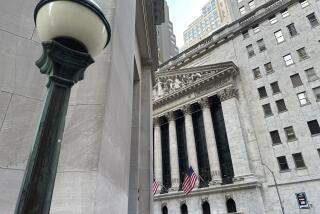Investors rush to safety amid another big drop in U.S. stocks
Reporting from New York and Los Angeles — With another big drop in U.S. stocks, the rush to safety has reached new levels.
The desire to shift money in the traditional haven of Treasury bonds Thursday led investors to accept the lowest-ever rate on a 10-year government bond. The yield briefly fell below the once unthinkable level of just below 2%. At the end of the day it was 2.06%, down from 2.17% a day earlier.
Gold, another favorite of anxious investors, continued to climb to new highs, trading at $1,824 an ounce, 48% higher than a year ago.
The shifts into gold and Treasury bonds came after the stock market snapped three calm days with a sharp drop for major U.S. indexes.
“It’s really a creeping crisis of confidence that is showing through,” said Steve Ricchiuto, chief economist at Mizuho Securities.
Many bond market pros say that no one who’s buying 10-year bonds yielding near 2% believes that it’s a great long-term return. But investors know that a weakening economy usually translates into lower interest rates, or at least keeps a lid on rates. That’s enhancing Treasuries’ traditional role as a haven, regardless of Standard & Poor’s downgrade of the government’s debt rating.
“You’ve got some price-insensitive [bond] buyers coming out of stocks and going into Treasuries,” said Mike Kastner, a partner at Halyard Asset Management in White Plains, N.Y. “I think it’s a deer-in-the-headlights-type reaction — nobody knows what to do.”
The Dow Jones industrial average ended the day down 419.63 points, or 3.7%, at 10,990.58. The broader Standard & Poor’s 500 index fell 53.24 points, or 4.5%, to 1,140.65. The sharpest drop came in the technology-heavy Nasdaq composite index, which finished down 131.05 points, or 5.2%, at 2,380.43.
Some traders said the best they could say about Thursday was that key stock indexes held above their recent lows. The Dow, for example, ended 271 points above its 11-month closing low of 10,719 reached Aug. 10.
Falling through last week’s lows could bring a new torrent of selling by demoralized investors, some analysts warn.
“If we break through those levels, I don’t know who’s going to move in to buy” stocks, said Larry Peruzzi, senior trader at Cabrera Capital Markets in Boston.
Investors started this week at ease, pushing stock prices higher after several upbeat earnings reports and a new burst of merger activity. That ended Thursday when Wall Street turned its attention once again to the troubles in the European financial system.
The European Central Bank revealed that an unnamed bank had borrowed $500 million through a generally unused emergency program. This was followed by a report indicating that U.S. regulators were giving extra scrutiny to the U.S. branches of European banks.
Both reports revived fears that European banks are vulnerable to the sovereign debt problems wracking the continent’s weaker economies. With memories of the Lehman Bros. collapse still very raw, the prospect of a European bank failing was enough to unnerve many investors.
“The last thing that hurt you is what you are scanning the horizon for,” said Kim Caughey Forrest, a portfolio manager at Fort Pitt Capital Group. “They don’t want another Lehman to hit them.”
European bank stocks helped drag leading indexes down 5.5% in France and 5.8% in Germany.
When the attention turned to the U.S., the news was little better.
Before the markets opened Thursday, the Labor Department said the number of new people filing for unemployment benefits last week had risen slightly. A report later in the morning showed that the sales of new homes had fallen more sharply than economists expected in July.
Investors, though, appeared to be most disappointed by the Federal Reserve Bank of Philadelphia’s monthly index of economic activity in the mid-Atlantic region, which plummeted to a negative 30.7 this month, down from a positive 3.2 in July. It was the lowest reading since March 2009, at the depth of the last recession.
Goldman Sachs economists said in a note that similar declines in the past have “only been observed in or immediately prior to recessions,” with one exception.
Neil Dutta, an economist at Bank of America Merrill Lynch in New York, said the Philadelphia Fed index and others like it had typically been sensitive to swings in the stock market.
With market volatility exploding since late July and share prices plunging, Dutta said, “The question at hand is whether the weakness in market sentiment prompts businesses to stop investing and consumers to stop spending.”
Economists are still debating how bad economic conditions already are. Morgan Stanley economists sent out a report Thursday lowering their predictions for how fast the economy will grow this year while speculating that the U.S. and Europe are “dangerously close to a recession.”
Federal Reserve Bank of New York President William Dudley was more upbeat Thursday, telling a crowd in New Jersey that he expected the economy to continue growing after a slow first half of the year. “We very much still expect the economy to recover,” he said.
Peter Andersen, a portfolio manager at Congress Asset Management, is another analyst who sees strength in the economy. But pessimists are in control and driving stocks down, he said.
“You have an overall negative bias penetrating all sectors and all markets,” Andersen said.
More to Read
Inside the business of entertainment
The Wide Shot brings you news, analysis and insights on everything from streaming wars to production — and what it all means for the future.
You may occasionally receive promotional content from the Los Angeles Times.










